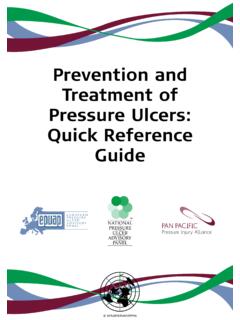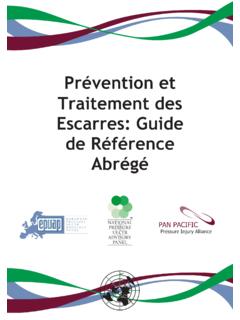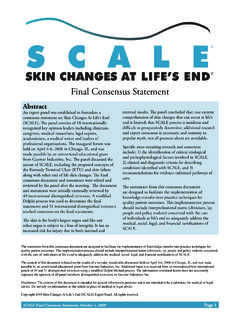Transcription of Quick Reference Guide Prevention - European Pressure …
1 Quick Reference Guide Prevention Introduction This Quick Reference Guide summarizes evidence-based guidelines on Pressure ulcer Prevention and treatment . It was developed as a 4-year collaborative effort between the European Pressure ulcer Advisory Panel (EPUAP) and American National Pressure ulcer Advisory Panel (NPUAP). The more comprehensive Clinical Practice Guideline version of the guideline provides a detailed analysis and discussion of available research, critical evaluations of the assumptions and knowledge of the field, a description of the methodology used to develop guideline, and acknowledgments of editors, authors, and other contributors. This Quick Reference Guide contains excerpts from the Clinical Practice Guideline, but users should not rely on these excerpts alone. Printed copies of the English editions of both documents are available through the NPUAP website ( ).
2 The Quick Reference Guide has been translated into several languages; translations are available on the EPUAP. website ( ). The goal of this international collaboration was to develop evidence-based recommendations for the Prevention and treatment of Pressure ulcers that could be used by health care professionals throughout the world. An explicit scientific methodology was used to identify and evaluate available research. In the absence of definitive evidence, expert opinion (often supported by indirect evidence and other guidelines) was used to make recommendations. Guideline recommendations were made available to 903 individuals and 146. societies/organizations registered as stakeholders in 63 countries on 6 continents. The final guideline is based on the available research and the accumulated wisdom of the EPUAP, NPUAP, and international stakeholders.
3 Suggested Citation The EPUAP and NPUAP welcome the use and adaptation of the guidelines at a national and local level. However, we request citation as to the source, using the following format: European Pressure ulcer Advisory Panel and National Pressure ulcer Advisory Panel. Prevention and treatment of Pressure ulcers: Quick Reference Guide . Washington DC: National Pressure ulcer Advisory Panel; 2009. 1. Quick Reference Guide Prevention International Guideline Prevention of Pressure Ulcers: Quick Reference Guide European Pressure ulcer Advisory Panel &. National Pressure ulcer Advisory Panel 2009. Additional printed copies are available through the National Pressure ulcer Advisory Panel ( ). 2. Quick Reference Guide Prevention Limitations and Appropriate Use of This Guideline Guidelines are systematically developed statements to assist practitioner and patient decisions about appropriate health care for specific clinical conditions.
4 The recommendations may not be appropriate for use in all circumstances. The decision to adopt any particular recommendation must be made by the health care professional in light of available resources and circumstances presented by the individual patient. Nothing contained in this guideline is to be considered medical advice for specific cases. Because of the rigorous methodology used to develop this guideline, the NPUAP and EPUAP believe that the research supporting these recommendations is reliable and accurate. However, we do not guarantee the reliability and accuracy of individual studies referenced in this document. This guideline and any recommendations herein are intended for educational and informational purposes only. This guideline contains information that was accurate at the time of publication. Research and technology change rapidly and the recommendations contained in this guideline may be inconsistent with future advances.
5 The health care professional is responsible for maintaining a working knowledge of the research and technological advances that may affect his/her practice decisions. Generic names of products are provided. Nothing in this guideline is intended as an endorsement of a specific product. Nothing in this guideline is intended as advice regarding coding standards or reimbursement regulations. 3. Quick Reference Guide Prevention Table of Contents Purpose and Scope 5. Methods 5. International NPUAP-EPUAP Pressure ulcer Definition 7. International NPUAP-EPUAP Pressure ulcer Classification System 7. Pressure ulcer Prevention Recommendations: Risk Assessment 9. Skin Assessment 11. Nutrition for Pressure ulcer Prevention 13. Repositioning for the Prevention of Pressure Ulcers 15. Support Surfaces 18. Special Population: Patients in the Operating Room 21.
6 Acknowledgments 4. Quick Reference Guide Prevention Purpose and Scope The overall purpose of this international collaboration was to develop evidence- based recommendations for the Prevention and treatment of Pressure ulcers that could be used by health care professionals throughout the world. A joint Guideline Development Group with representatives from both the NPUAP and EPUAP planned the guideline development process and reviewed all the documentation. However to simplify logistics, the EPUAP took the lead on the Pressure ulcer Prevention recommendations and NPUAP on the Pressure ulcer treatment recommendations. The purpose of the Prevention recommendations is to Guide evidence-based care to prevent the development of Pressure ulcers. The Prevention recommendations will apply to all vulnerable individuals of all age groups. The guideline is intended for the use of health care professionals who are involved in the care of patients and vulnerable people who are at risk of developing Pressure ulcers, whether they are in a hospital, long-term care, assisted living at home or any other setting, and regardless of their diagnosis or health care needs.
7 It will also help to Guide patients and carers on the range of Prevention strategies that are available. Methods A rigorous and explicit methodology was used in the development of these guidelines. (See the Clinical Practice Guidelines for a more detailed description.). All evidence was reviewed for quality. Individual studies were classified by design and quality (see Table 1). The cumulative body of evidence supporting each recommendation was examined; a Strength of Evidence rating was assigned using the criteria in Table 2. 5. Quick Reference Guide Prevention Table 1. Level of Evidence for Individual Studies Level 1 Large randomized trial(s) with clear-cut results (and low risk of error). 2 Small randomized trial(s) with uncertain results (and moderate to high risk of error). 3 Non randomized trial(s) with concurrent or contemporaneous controls 4 Non randomized trial(s) with historical controls 5 Case Series with no controls.
8 Specify number of subjects. Adapted from Sackett, 1989. See the Clinical Practice Guideline for a discussion of the guideline development methodology. Table 2. Strength of Evidence Rating for Each Recommendation Strength of Evidence The recommendation is supported by direct scientific evidence from properly designed and implemented A controlled trials on Pressure ulcers in humans (or humans at-risk for Pressure ulcers), providing statistical results that consistently support the guideline statement (Level 1. studies required). The recommendation is supported by direct scientific evidence from properly designed and implemented clinical B series on Pressure ulcers in humans (or humans at-risk for Pressure ulcers), providing statistical results that consistently support the recommendation. (Level 2, 3, 4, 5. studies). The recommendation is supported by indirect evidence C ( , studies in normal human subjects, humans with other types of chronic wounds, animal models) and/or expert opinion.
9 This clinical practice guideline is based on the current research and will need revision in the future as new evidence is published. Future research should focus on the areas where evidence is absent or weak. 6. Quick Reference Guide Prevention International NPUAP-EPUAP Pressure ulcer Definition A Pressure ulcer is localized injury to the skin and/or underlying tissue usually over a bony prominence, as a result of Pressure , or Pressure in combination with shear. A number of contributing or confounding factors are also associated with Pressure ulcers; the significance of these factors is yet to be elucidated. Development of an International Pressure ulcer Classification System As part of the guideline development process, the NPUAP and EPUAP developed a common international definition and classification system for Pressure ulcers. Over the past several years, members of the two organizations have had ongoing discussions about the many similarities between the NPUAP and EPUAP Pressure ulcer grading/staging systems.
10 As we release an international Pressure ulcer Prevention and treatment guideline, we consider this the ideal time to develop a common classification system that can be used by the international community. Staging/grading implies a progression from I to III or IV, when that is not always the case. We attempted to find a common word to describe the stage or grade and could not do so. Category was suggested as a neutral term to replace stage or grade. Although foreign to those accustomed to other terms, category has the advantage of being a non-hierarchical designation, allowing us to free ourselves from the mistaken notions of progressing from I to IV and healing from IV to I.. We recognize that there is a familiarity to the words stage and grade, and therefore we are proposing to use whatever word ( , stage, grade, or category) is most clear and understood.











